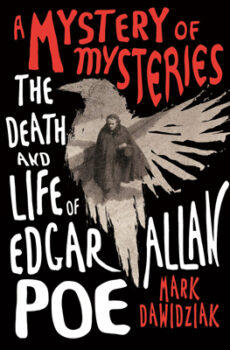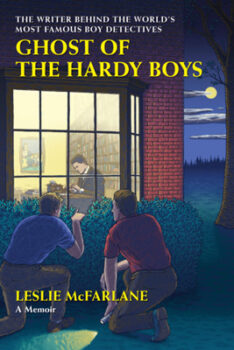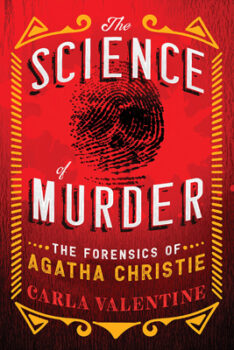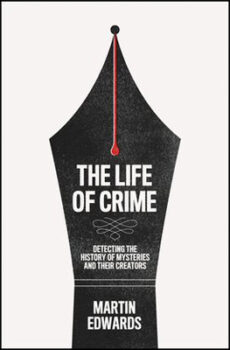Stranger Than Fiction
April 2023
Just the Facts
by Dean Jobb
How sound is the forensic science in Agatha Christie’s mystery novels and stories? Who was Franklin W. Dixon, the author whose name appeared on the covers of the Hardy Boys books? And what caused the mysterious death of Edgar Allan Poe, the master of gothic horror and the architect of the modern detective story? Here is a roundup of recent nonfiction books that explore the facts behind crime fiction.
Let’s start with a mystery worthy of the formidable deductive powers of Poe’s fictional detective, C. Auguste Dupin. On October 3, 1849 a man was found on a Baltimore street, outside a tavern. He was semiconscious, “in great distress” and “in need of immediate assistance,” according to the man who came to his aid. He was incoherent, disheveled, and clad in ill-fitting clothes that were not his own. Rushed to hospital, he apparently kept asking for someone named Reynolds. Within four days, he was dead. The man who found him recognized the famous writer, but everything else about Poe’s death was—and remains—shrouded in mystery. Why had he stopped over in the city, when he was supposed to be on his way to New York? Where were his clothes? Was he drunk or ill? Who was Reynolds? And what was the cause of Poe’s sudden death?
 These are the questions author Mark Dawidziak strives to answer in A Mystery of Mysteries: The Death and Life of Edgar Allan Poe (St. Martin’s Press), a biography of the towering literary figure that’s told through the lens of a premature death (he was only forty) as bizarre and bewildering as the ones he concocted for characters in his works of horror. “Like so many aspects of his life,” the author notes, “his death has been the topic of endless debate, conjecture, speculation, guessing, and second-guessing.”
These are the questions author Mark Dawidziak strives to answer in A Mystery of Mysteries: The Death and Life of Edgar Allan Poe (St. Martin’s Press), a biography of the towering literary figure that’s told through the lens of a premature death (he was only forty) as bizarre and bewildering as the ones he concocted for characters in his works of horror. “Like so many aspects of his life,” the author notes, “his death has been the topic of endless debate, conjecture, speculation, guessing, and second-guessing.”
With no Dupin around to crack this 174-year-old cold case, Dawidziak turned to experts on all things Poe—an impressive lineup of biographers, historians, literary critics, scholars, museum curators, and horror writers who have drawn inspiration from the master of the macabre, among them Stephen King. The more than fifty persons interviewed include forensic and medical specialists, actors who appeared in movies based on Poe’s works, and one of Poe’s cousins. And the cause of death? Take your pick—an array of culprits, from murder or suicide to binge drinking, rabies, or syphilis have been suggested over the years.
Fans of Poe and his works will love this engaging book. It’s loaded with insights and draws on bookshelves’ worth of previous studies to immerse readers in the controversies and debates. And since the book is as much about Poe’s life as it is about his death, the retelling of the writer’s career and accomplishments is intertwined with the exploration of his demise. The result is a deeper and richer understanding of Poe, challenging the tortured, troubled “grandfather of Goth” caricature that his strange death has frozen in time. Can Dawidziak pull off a coup worthy of Dupin and solve the mystery behind what he calls “one of the great literary stage exits of all time”? Like a good detective, he interrogates and eliminates the many lethal suspects until only one cause of death appears likely and logical.
 The Great Author Mystery sounds like a puzzle worthy of the talents of the Hardy Boys, the fictional teenage brothers Frank and Joe who battled crime and solved mysteries in their equally fictional hometown of Bayport, somewhere on the Atlantic coast. Fifty-eight books in the original Hardy Boys series were published between 1927 and 1979 and spinoffs and adaptations continue to appear. Young readers can’t get enough of the boys’ adventures, which have sold an astounding 70 million copies over the years.
The Great Author Mystery sounds like a puzzle worthy of the talents of the Hardy Boys, the fictional teenage brothers Frank and Joe who battled crime and solved mysteries in their equally fictional hometown of Bayport, somewhere on the Atlantic coast. Fifty-eight books in the original Hardy Boys series were published between 1927 and 1979 and spinoffs and adaptations continue to appear. Young readers can’t get enough of the boys’ adventures, which have sold an astounding 70 million copies over the years.
The series’ author, Franklin W. Dixon, must have struck it rich. Who was he? That’s the mystery. The plucky all-American boys came to life in a backwoods cabin in Canada, in the imagination of a young Ontario newspaperman who dashed off the books for small paychecks in order to make ends meet. His name was Leslie McFarlane and he wrote twenty-one of the books, starting with the sleuths’ debut in The Tower Treasure in 1927. His identity remained almost unknown until shortly before his death in 1977 when he published a memoir reissued in 2022 as Ghost of the Hardy Boys: The Writer Behind the World’s Most Famous Boy Detectives (Godine).
McFarlane’s adventure began in the early 1920s, when he answered an intriguing classified advertisement: “Experienced Fiction Writer Wanted to Work from Publisher’s Outlines.” He had no experience writing fiction, but he answered the ad and began providing manuscripts to Edward Stratemeyer. McFarlane called him “a Henry Ford of fiction for boys and girls,” who churned out ideas for juvenile fiction and hired writers to do the heavy lifting. His New Jersey-based Stratemeyer Syndicate retained McFarlane to write instalments of the now-forgotten underwater adventures of diver Dave Fearless, then launched the Hardy Boys. Stratemeyer provided the characters’ names and chapter outlines and McFarlane did the rest. He received a check for $125—equivalent to about $2,000 today—for each book, but no royalties and no credit.
McFarlane, not surprisingly, spins a great yarn, and his memoir is filled with insights and wry humor. He never knew what the middle initial “W” stood for in his assigned pen name, he writes, but it was “certainly not Wealthy.” Anyone who read the Hardy Boys in their youth will be fascinated with the series’ origin story. And how did McFarlane wind up being nominated for an Academy Award? Dive into this thoroughly enjoyable book and find out.
 Here’s an unconventional guide to the history and development of police investigative procedures and forensic science—the novels and short stories of Agatha Christie. Carla Valentine, a former mortuary assistant turned author and blogger, uses the works of the world’s best-selling mystery author as a jumping-off point to explore the real-life techniques Christie used to solve her fictional crimes.
Here’s an unconventional guide to the history and development of police investigative procedures and forensic science—the novels and short stories of Agatha Christie. Carla Valentine, a former mortuary assistant turned author and blogger, uses the works of the world’s best-selling mystery author as a jumping-off point to explore the real-life techniques Christie used to solve her fictional crimes.
Each chapter in The Science of Murder: The Forensics of Agatha Christie (Sourcebooks) highlights a forensic or investigative tool, from fingerprints and ballistics to blood spatter and toxicology, that figures in Christie’s books. While poison was often Christie’s preferred means of eliminating characters, Valentine notes, there are more references to fingerprints in her novels than to any other forensic science. And it was largely through her work and the books of her fellow writers published between the world wars, during the Golden Age of Detective Fiction, that new scientific and investigative techniques were popularized. After all, why would Captain Hastings slog through a dry textbook when his friend Hercule Poirot is only too happy to explain to him—and to readers—how evidence is gathered and analyzed?
Valentine explores each subject with easy-to-grasp explanations, brief forays into history, and breezy writing (accompanied by an annoying fondness for exclamation marks). Christie fans will enjoy finding out more about the forensic techniques her characters refer to or employ. She was a diligent researcher who knew her stuff and has been credited as the first person to use the term “the scene of the crime” (in the novel The Murder on the Links, published in 1923). The Science of Murder is a reminder that Poirot used more than his famous “little gray cells” to find out the truth.
Anyone who scrolls through the program lineup on Netflix and other streaming services can be forgiven for thinking we’re in the midst of a serial-killing epidemic. There seems to be no end to the documentaries, true crime investigations, movies, and series based on real events and fictionalized accounts of the murderous exploits of the most feared and reviled criminals on the planet. Serial killers—as well as their victims and the detectives and forensic specialists who pursue them—have become a macabre force in a culture that seems incapable of looking away. Not everyone can name the second president of the United States, but you would be hard pressed to find someone who has not heard of Ted Bundy or Jeffrey Dahmer.
Canadian academic Sarah E. Fanning and Claire O’Callaghan, a lecturer at a British university, have teamed up to edit Serial Killing on Screen: Adaptation, True Crime and Popular Culture (Palgrave Macmillan), a collection of fourteen essays on how movie studios, documentary producers, and screenwriters have portrayed serial murderers from Aileen Wuornos to the Zodiac killer. This team of scholars from as far afield as Austria and Australia sets out to address how real-life killers and their “horrific crimes and traumatic legacies” are presented on-screen and the ethical dilemmas of turning them into cultural and media phenomena.
The collection is “a starting point with which to grapple with the onscreen adaptation of some of society’s darkest—and in some cases unsolved—crimes,” the editors explain in an introduction. “Many of the chapters investigate the boundary between truth and fiction, that which is verifiably ‘real’ and that which is invented for dramatic value.” It’s a comprehensive guide with insights into the industry that has grown up around serial killers, from Hollywood blockbusters and true crime podcasts to T-shirts, trading cards, action figures, and other ghoulish “murderabilia” marketed to fans. The essays range from studies of recent depictions of Jack the Ripper and serial killers popping up in American sitcoms to a search for the meaning behind David Lynch’s strange, groundbreaking Twin Peaks. There’s even a segue into serial-killer musicals, which turn out to be a thing. These scholarly studies stress analysis over storytelling, but the familiar figures and well-known screen adaptations each author tackles will appeal to serious students of true crime.

Raise your hand if you can name someone more knowledgeable about the history of detective fiction and crime and mystery writing than the prolific British writer Martin Edwards. No one? That’s not surprising. Edwards, the award-winning author of the Lake District Mysteries, has published seventeen crime novels and more than a half-dozen nonfiction books on the genre and its practitioners. He’s president of the Detection Club, the group of elite mystery writers which counted Christie as one of its founding members. He’s a consultant to the British Library’s crime classics series and a former chair of Britain’s Crime Writers’ Association.
His latest must-have book, The Life of Crime: Detecting the History of Mysteries and their Creators (Collins Crime Club), offers fifty-five chapters packed with crime-genre history, criticism, anecdotes, and insights. Poe, Christie, and Sherlock Holmes have their own chapters, of course, but there are also studies of true crime pioneer F. Tennyson Jesse, radio mysteries, “comedy and crime,” East Asian detective fiction, and Sue Grafton and other female authors who have created private eyes. When a reviewer with the stature of the Washington Post’s Michael Dirda calls it “a magisterial work,” who can argue?
Edwards’s book is a successor to Julian Symons’s Bloody Murder (published in the U.S. under the title Mortal Consequences), the go-to guide to crime fiction since it first appeared a half-century ago. The Life of Crime offers a fresh, updated take on the genre. It’s sure to fuel debate on whose books received too much attention and whose were overlooked (as Dirda did in his review in the Post). “I haven’t confined myself to examining the usual suspects,” Edwards notes. “Gems lurk in dusty corners.”
And relax—there’s plenty of material on Frederic Dannay and Manfred Bennington Lee, who wrote under the pen name Ellery Queen, and the eponymous magazine Dannay founded in 1941 to showcase the work of new and established crime and mystery writers. Edwards, among his many accomplishments, is a three-time winner of the Bristol Crimefest’s Mastermind Quiz. Read this book and you’ll know why.
———
Esquire magazine recently selected Dean Jobb’s true crime book Empire of Deception: The Incredible Story of a Master Swindler Who Seduced a City and Captivated the Nation (Algonquin Books) as one of the 50 best biographies of all time. He teaches in the MFA in Creative Nonfiction program at the University of King’s College in Halifax, Nova Scotia. Find him at www.deanjobb.com.
